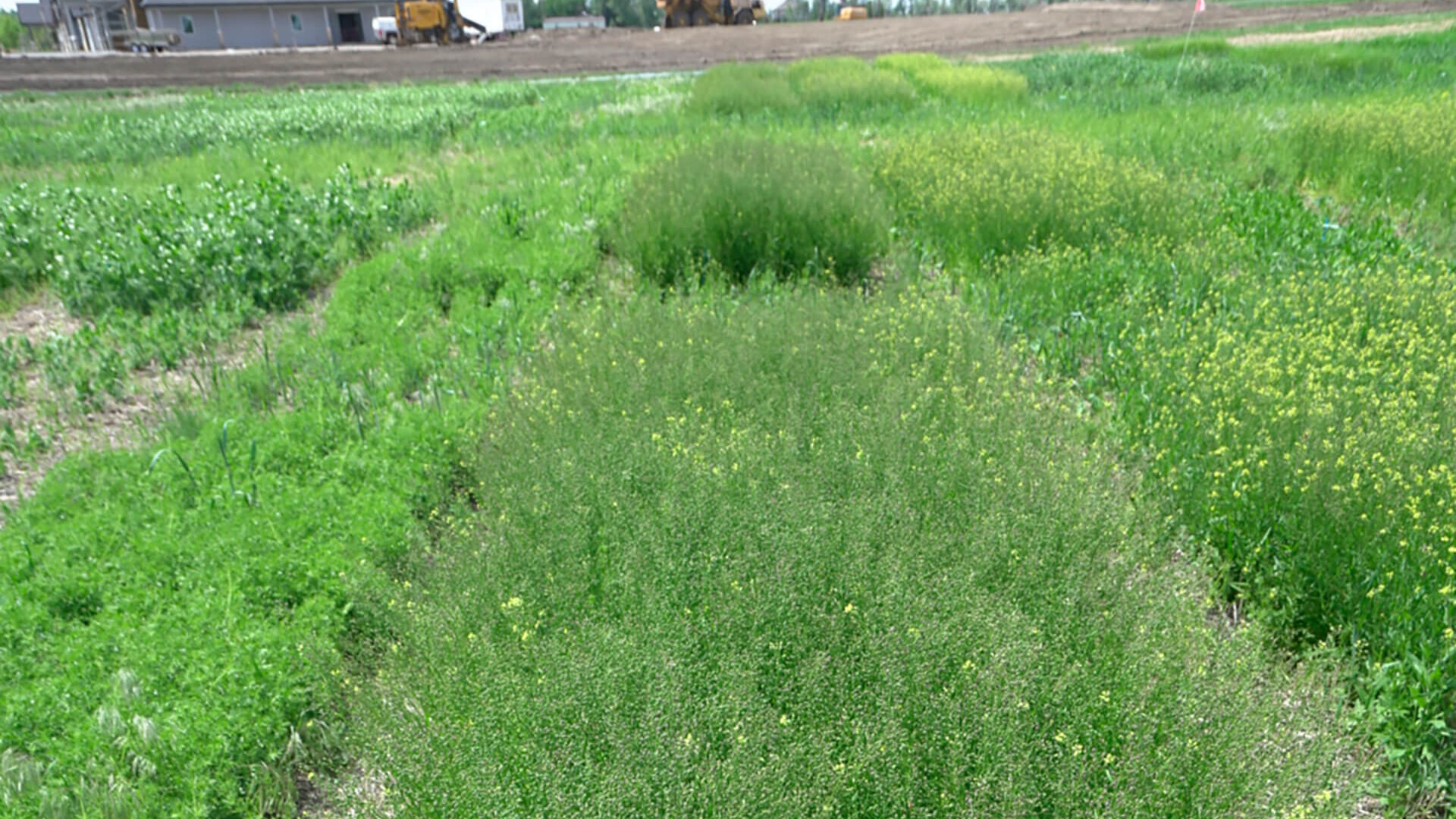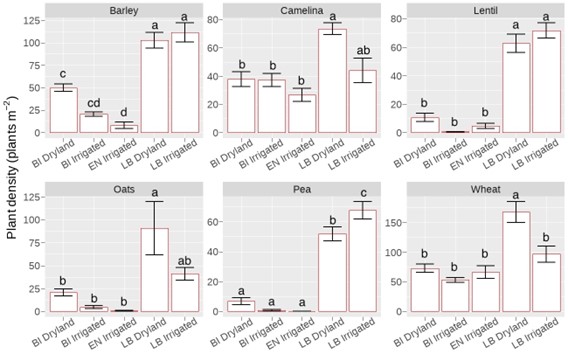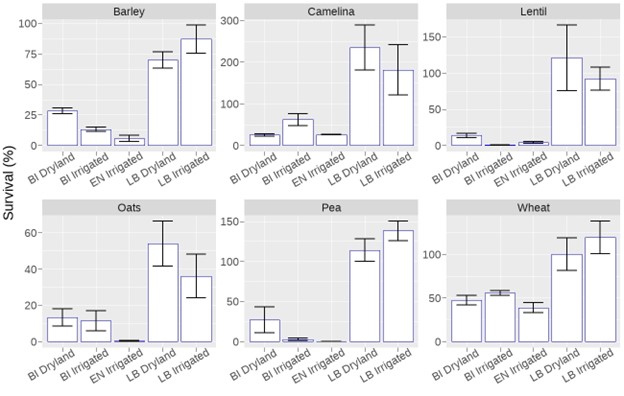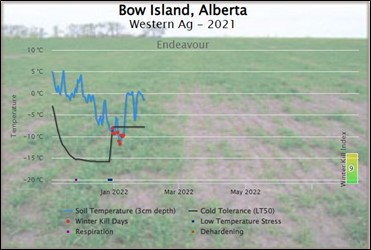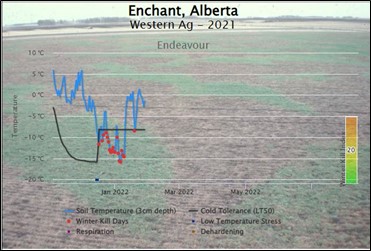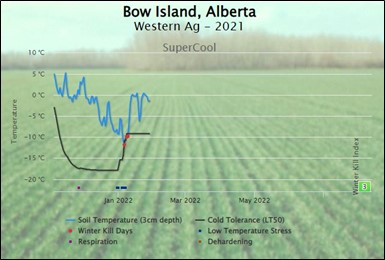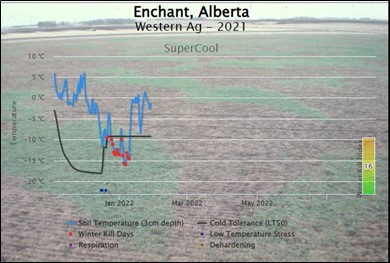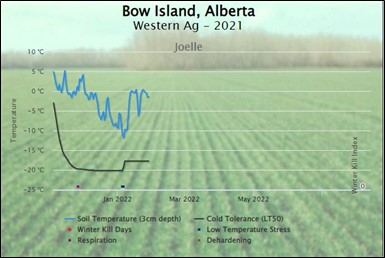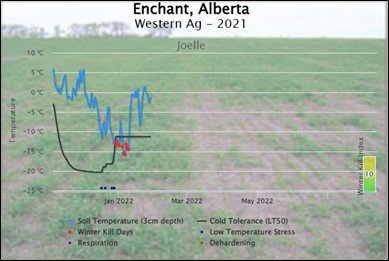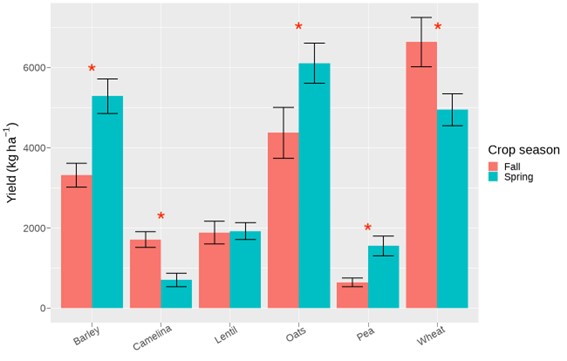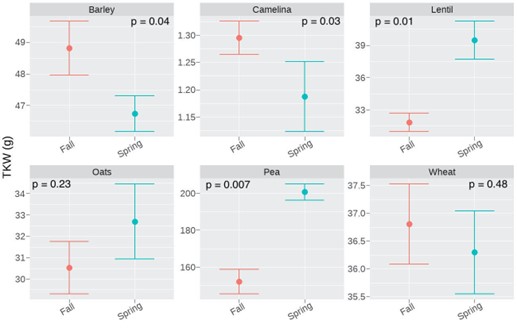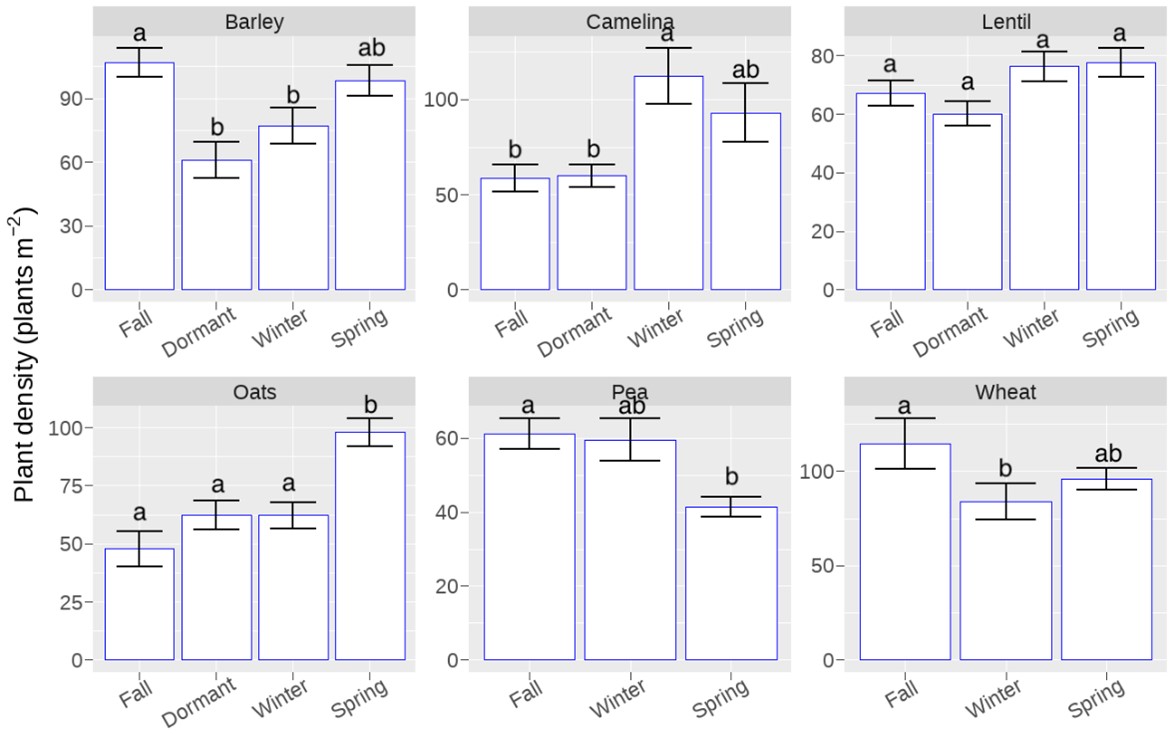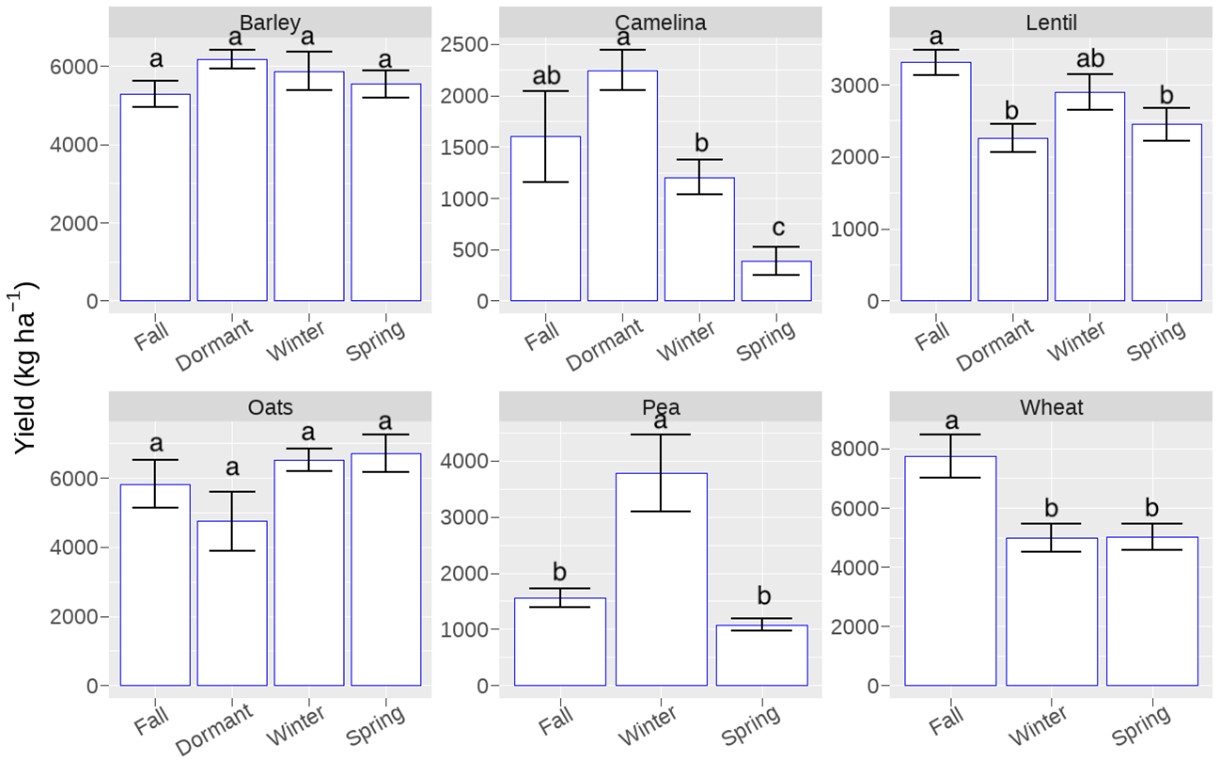BackgroundWinter crops provide a distinct advantage over spring crops in extending the growing season under western Canadian conditions. Their longer period of growth compared to spring crops generally leads to higher grain yield in addition to limiting weed pressure and soil erosion. Due to these reasons, there is high interest among the producers for winter crop cultivation. However, limited information is available to them regarding the best management practices and varieties suitable for western Canadian conditions especially in the case of novel crops such as winter durum, oats, barley, faba beans etc. This study intends to enhance the adaptability of novel, fall-seeded pulse, and cereal crops through variety screening for western Canadian growing conditions and through seed treatment application. This study was conducted at six locations in Alberta for a single growing season (fall-seeding 2021). 8 novel crops, including winter barley, oats, durum, wheat, pea, lentils, and camelina will be evaluated for fall-seeded crop production through the screening of recently developed varieties. The varieties to be screened will be chosen based on the winter cereal survival model developed by Byrns et al. (2020). This project will provide information to western Canadian producers about the agronomic feasibility of winter production of novel pulse and cereals. |
|
||||||||||
Project ObjectivesThe major purpose of this project is to enhance the adoption of novel winter crops in southern Alberta through the screening and recommendation of crop varieties favorable to growing conditions in western Canada, and through the application of seed treatments.
|
||
MethodsSmall plot research trials were conducted separately for six winter crops including winter barley, oats, wheat, pea, lentils, and camelina using randomized complete block design (RCBD) at three locations in southern Alberta including Lethbridge, Bow Island, and Enchant. The research trials were conducted under dryland and irrigated conditions at all sites for one growing season in 2021-2022. A total of 34 cultivars for the winter crops listed above were evaluated in these trials. Farming Smarter partnered with Ken Greer and Dr. Eric Bremer (Western Ag group of Companies) to source these recently developed cultivars from Canada, Germany, Poland, USA etc. The experimental design included a factorial combination of a) crop cultivars and b) seeding timings. For the Lethbridge site, four seedling timings were included – fall (last two weeks of September), dormant (mid-November), winter (mid to late March) and spring (late April and early May) seeding timings. For the Bow Island and Enchant locations, two seeding timings, i.e., fall and spring seeding timings were included. Measurements
|
ResultsEffect of environmental conditions – This project was carried out at three locations in southern Alberta including sites at Lethbridge, Enchant and Bow Island. The plant establishment in the fall season did not show major differences between locations for barley, camelina, lentil and wheat crops (Figure 1a). However, major differences were observed for the spring plant density and overwintering survival between the locations for all crops (Figure 1b and 1c).
Low overwinter survival combined with severe drought conditions in 2021 and early spring of 2022 led to very poor crop survival at the dryland site in Enchant. Consequently, crop performance and yield data from Enchant dryland site was excluded from the overall analysis, which was limited to the remaining five sites. Low overwinter survival not only impacted crop yield directly but also reduced the competitive ability of crops against weed pressure by reducing plant density. As a result, the plots for oats and pea crops at Bow Island and Enchant sites, and lentil plots at the irrigated site in Bow Island showed extremely low plant survival and yield. The overwintering survival and spring plant density at the Lethbridge site was significantly higher compared to the Bow Island and Enchant locations for all crops (Figure 1b and 1c). The overwintering survival for Barley, Camelina, Lentils, Oats, and Pea was less than 30% in most of the cases for Bow Island and Enchant sites, while the Lethbridge site showed very high overwintering survival. The model output for Endeavour variety of Barley highlighted the differences in environmental conditions at the three sites which were clearly linked to different low-temperature stress and winter kill indices (Figure 2).
The winter kill index for the Endeavor variety of Barley was estimated to be only 5 at Lethbridge with relatively few winter-kill days (Figure 2a). On the other hand, the winter kill index for this variety was 9 at Bow Island (Figure 2b) and 20 at the Enchant location (Figure 2c) with a higher frequency of winter-kill days. Both locations had low temperature stress periods around December 2021 to January 2022 that reduced the cold tolerance (LT50) of the variety as estimated by the winter cereal survival model. The soil temperature was recorded to be higher than -10 oC throughout the winter season for Lethbridge, and for most of the season in the case of Bow Island site (Figure 3a and 3b). However, the Enchant location showed a higher winter kill index of 16 for the Supercool cultivar due to a series of winter kill days at the end of December and beginning of January (Figure 3c).
Similar trends can also be observed for the cold tolerance of ‘Joelle’ cultivar of camelina at Lethbridge, Bow Island, and Enchant sites (Figure 4).
However, the Enchant location had a series of low-temperature days towards the last week of December and first few weeks of January that drastically impacted crop performance and reduced its suitability for winter crop production. These trends are, however, based on a single year of data collection and should be verified by repeating these measurements for additional years at southern Alberta sites. Comparison with spring seeded crops – The performance of fall-seeded crops was compared to the spring-seeded crops to obtain a better idea of their relative performance. The relative plant emergence of spring seeded crops was generally higher than the fall seeded crops in all crops except for camelina, where plant emergence in spring- and fall-seeded camelina was not different (Figure 5).
In general, the fall-seeded crops were able to compensate for relatively less plant emergence due to longer growing season and higher availability of moisture through spring snowmelt. This observation is supported by the determination of their relative canopy closures measured in mid-June 2022. The fractional green canopy cover (FGCC) of fall-seeded crops were significantly higher than the spring-seeded crops in case of lentils, peas, and wheat (Figure 6). In the case of barley, camelina, and oats, the FGCC measurements did not show a statistically significant difference between fall- and spring-seeded crops.
The yield performance of fall- and spring seeded crops varied by the type of crop. The spring-seeded cultivars had a higher average yield in the case of barley, oats, and field peas (Figure 7a). Conversely, in the case of camelina and wheat, the fall-seeded cultivars showed higher yield and thousand kernel weight (TKW) compared to the spring seeded cultivars (Figure 7a and 7b).
At the Lethbridge site, crops were seeded at four timings including the regular fall seeding (late September), dormant seeding (November), late winter seeding (March) and regular spring seeding (late April). For the cereal crops including wheat, barley, and oats, while the plant establishment was reduced for dormant or winter seeding times, overall yield did not show a significant difference for different seeding timings for barley and oats (Figure 8).
Late seeding in March favored certain cultivars such as pulse crops and camelina that do not require vernalization and were able to utilize the soil moisture from spring snow melt without getting exposed to severe cold spells during January and February (Figure 8). The major findings from this project:1. Fall-seeded production can be a valuable option for many crops specifically camelina, lentils, and wheat. It enables them to use excess moisture from spring snow melt which can be especially valuable during drought-affected years. The cultivars that do not require vernalization can also potentially be seeded in late winter/early spring periods such as February and March to derive similar advantages. 2. There is a major role of environmental conditions, especially the frequency of winter kill-days, in determining the overwintering survival and performance of fall-seeded crops. Based on the findings of this project, Lethbridge is more suited to fall-seeded crop production compared to other southern Alberta locations due to lesser duration of winter kill period. However, these findings are based on a single year of data collection and should be verified by repeating these measurements for additional years at southern Alberta sites. 3. The performance of different cultivars depends on their cold tolerance (LT50) and the environmental conditions (especially soil temperature) during the growing season at their growing site. As an example, the 'endeavor' cultivar of barley had an average yield of 5060 kg/ha at the Bow Island site and 3814 kg/ha at the Lethbridge site but had to be terminated due to poor overwintering survival at the Enchant site due to comparatively low soil temperature at this site. The winter cereal survival model can be reliably used to predict cultivar performance based on the environmental conditions at a given site. |
||||||||||||||||||||||||||||||||||||
Recommendations1. Consider fall seeding: Fall-seeded crops have a longer growing season and higher availability of moisture through spring, which can help compensate for relatively less plant emergence. Farmers should consider fall seeding as a viable option for crop production. On average, Fall/Winter seeding timings performed as good or better than their Spring counterpart. 2. Choose crop varieties that are suitable for the local environmental conditions: The significant effect of environmental conditions on the establishment, growth, and yield of fall-seeded crops. Farmers should carefully select crop varieties that are better adapted to their specific location to improve their chances of success. For example, 'Joelle' camelina, yellow or 'Supercool' lentils, or 'Endeavor' barley, as they all had standout performances. 3. Control weed pressure: Low overwinter survival not only impacts crop yield directly but also reduces the competitive ability of crops against weed pressure by reducing plant density. Farmers should implement effective weed control measures to improve their crop performance. 4. Monitor and collect long-term data for analysis: Conduct long-term data collection and analysis on winter temperature conditions and soil temperature to allow for informed decisions about crop variety selection and seeding practices. Farming Smarter continues to advance winter crop knowledge in southern Alberta with Western Ag Innovations. Project Video
|
|||||
Articles
This winter, we're exploring the adaptability of crops for winter!
In a one-year partnership study with Western Ag Innovations, Farming Smarter is investigating which crops can be best adapted for winter.

